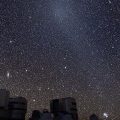Look skyward and here is what the beginner can see: seven objects to provide some entertainment for the year, even if under less than perfectly dark skies.
Let’s start with the most obvious of all: our Moon. It can be seen every month with our unaided eyes. Its phases increase from a thin sliver over the western horizon during the early evening until about two weeks later when its full phase illuminates the countryside enough for us to walk about without artificial lighting. It then shrinks to a thin sliver in the east visible a few hours before sunrise. Without binoculars, we easily see the face of the Man in the Moon when it is in full phase. But there is also the Old Woman, and other figures for those of us with a keen imagination.
The facial features are highlighted by bright and dark areas on the Moon. The brighter areas are old andbattered “highlands” caused by impacts from the accumulation of rock about 4-billion years ago, and these impacts continue today as smaller inter-planetary debris rains down on to the Moon and planets. These bodies hit the Moon from 10 to 70 kilometres per second, blasting countless craters into the surface.
“The light of the Moon makes observing all the other celestial objects that much more difficult.”
The darker areas are several hundred million years younger than the bright highlands, and have suffered less bombardment. The dark surfaces resemble flat seas, which earned them the Latin title “mare” (which translates to “sea”), but they are as far from water as you can get. In fact, they are solidified lava plains. With binoculars, you can easily see the variations in shades of grey in the mare, evidence that they were formed from numerous episodes of flooding by molten rock.
The larger craters we see are about a hundred kilometres in diameter. The crater Copernicus (93-km diameter) marks the nose of the Man in the Moon and the Tycho crater (86-km) appears as a dimple on his chin. The crater Plato (110-km) looks like a dark mole above the Moon’s right eye. The light of the Moon makes observing all the other celestial objects that much more difficult. Moonlight scatters across the sky, overwhelming fainter objects. But when the Moon shrinks to a thin crescent, it is time to hunt down fainter celestial prey.

Starting in January, the sky is dominated by the bright stars that make up the constellation of Orion the Hunter with his high shoulders and lower knees marked by four bright stars. Between them is a line of three stars representing his belt, and hanging from the belt are stars that represent his scabbard. A closer inspection with binoculars shows that the middle “star” in the scabbard is a hazy glow of interstellar gas, that is, a nebula. Our view is hindered by distance. The faint light that enters our eyes left it 1,300 years ago! It may not look like much, but it is a stellar nursery with enough gas to make 10,000 stars like our Sun.
The hazy band of the Milky Way dominates summer nights. As grand as it may be, it is often overwhelmed by artificial light. However, in remote areas, it is an unforgettable spectacle. It is composed of distant stars too faint to be seen individually, but their combined light produces the mottled structure that arcs across our summer sky from the southwest to northeast. The brighter areas are rich star fields while the dark regions are caused by interstellar dust and cold gas that obscures the more distant stars. Small fuzzy patches along the Milky Way are produced by star clusters, and there are interstellar clouds that are caused to fluoresce by neighbouring hot stars.
Use your binoculars to scan through the Milky Way. You will find about a dozen of these interesting objects. Several of them are low in the south above the asterism “The Teapot,” more officially called the constellation of Sagittarius. The brightest of these is called the Lagoon nebula. It is a stellar nursery with gas contracting to form hundreds of young stars. In front of the nebula you may see a faint cluster of stars that formed from the gas of the nebula, and this star formation continues today.
In autumn, we are looking into a sky with few prominent stars. One object in the autumn night is particularly unassuming—and humbling. Passing high overhead in the constellation of Andromeda is a faint streak of fuzzy light. With binoculars under a dark sky it stretches across the field of view. It is the Andromeda Galaxy: over 2.2-
million light years away, so distant that it is untouchable in even the Star Trek universe.
Winter returns with two more prominent objects visible even from the suburbs. Northwest of Orion is a V-formation of stars forming the head of Taurus the Bull. Called the Hyades star cluster, it is 150 light years away. Now compare it to another star cluster further to the west at the end of the Bull’s tail. This much smaller grouping of stars is the Pleiades cluster resembling a very small saucepan. These two objects are physically about the same size, but the Pleiades is about three times farther away.
In searching for these objects, you have probably lucked upon others. Keep it up and you’ll discover more.
One of Canada’s foremost writers and educators on astronomical topics, the Almanac has benefited from Robert’s expertise since its inception. Robert is passionate about reducing light pollution and promoting science literacy. He has been an astronomy instructor for our astronauts and he ensures that our section on sunrise and sunset, stargazing, and celestial events is so detailed and extensive it is almost like its own almanac.














